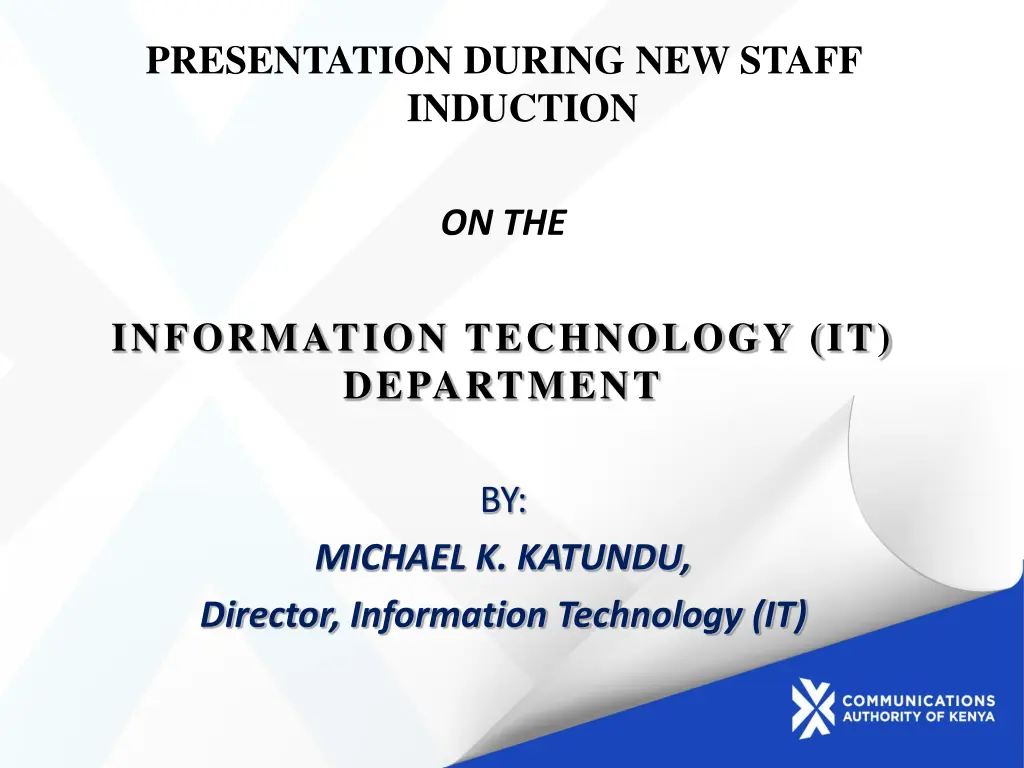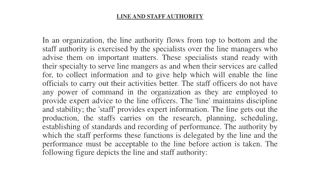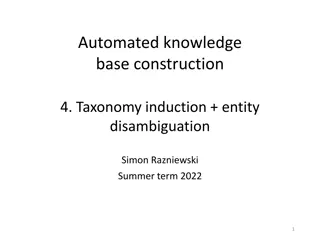
Maximizing the Impact of Kenya's IT Department Mandate
Explore the critical role of Kenya's Information Technology Department in aligning IT systems, fostering e-commerce development, and advancing cybersecurity initiatives. Gain insights into the national cybersecurity framework, ICT policies, and more.
Download Presentation

Please find below an Image/Link to download the presentation.
The content on the website is provided AS IS for your information and personal use only. It may not be sold, licensed, or shared on other websites without obtaining consent from the author. If you encounter any issues during the download, it is possible that the publisher has removed the file from their server.
You are allowed to download the files provided on this website for personal or commercial use, subject to the condition that they are used lawfully. All files are the property of their respective owners.
The content on the website is provided AS IS for your information and personal use only. It may not be sold, licensed, or shared on other websites without obtaining consent from the author.
E N D
Presentation Transcript
PRESENTATION DURING NEW STAFF INDUCTION ON THE INFORMATION TECHNOLOGY (IT) DEPARTMENT BY: MICHAEL K. KATUNDU, Director, Information Technology (IT)
Mandate of the IT Department 1. Align Information Technology (IT) systems to the Authority s Strategy 2. Facilitate the development of the Commerce (E-Commerce) Electronic framework in Kenya 3. Conduct technical Research and on new and Development (R&D) emerging technologies and trends
ALIGN INFORMATION TECHNOLOGY (IT) SYSTEMS TO THE STRATEGY AUTHORITY S
Align the Information Technology (IT) systems to the Authority s Strategy Automation of the Authority s systems and processes Management of the Authority s IT systems Awareness creation and capacity building on IT issues (Internal and Regulatory) Advise on IT issues (Internal and Regulatory)
FACILITATE THE DEVELOPMENT OF THE ELECTRONIC COMMERCE (E-COMMERCE) FRAMEWORK IN KENYA
Overview of Kenyas National Cybersecurity Framework VISION 2030 ICT Sector Policy Kenya Information & Communications Act of 1998 National Cybersecurity Strategy National Computer Incident Response Team/Co-ordination Centre (National KE-CIRT/CC) National Public Key Infrastructure (NPKI)
Facilitate the development of the Electronic Commerce) framework in Kenya Commerce (E- 2.1. Coordination of the implementation of the national Cybersecurity framework 2.2. Coordination of the implementation of a framework for the administration and management of the dot KE country code Top (ccTLD) Level Domain
Coordination of the implementation of the national Cybersecurity framework i. What is Cybersecurity: Cybersecurity is also referred to as Information Technology (IT) security; It s the protection of computers, networks, programs and data from unintended or unauthorized access, change or destruction. https://encrypted-tbn1.gstatic.com/images?q=tbn:ANd9GcQ4bt44XY33fdSKf6RU1zD67V4IvsUI7zw_eMDBV2xdN-dtukB7ow https://encrypted-tbn2.gstatic.com/images?q=tbn:ANd9GcTX92h9Zqe2RSANNSqQVcqa-WV6zu5toXDscGyzt1i3dbRaSRNsPw
Coordination of the implementation of the national Cybersecurity framework (Cont d) ii. Types of Cybersecurity incidents Hate messages propagated through the Internet/Computer; Distributed Denial of Service (DDOS); Phishing; Website Defacement; Espionage https://encrypted-tbn1.gstatic.com/images?q=tbn:ANd9GcSVFTU0nNA-NhNoocPlNGs8XWSlb5wkJI38JOVfd4mP3KgimIZf https://encrypted-tbn2.gstatic.com/images?q=tbn:ANd9GcTJ_HB_RupYCRtXBxcIBrBsuxIPD1vKF3PlBMDdv2Nvo1GR4DiJ https://encrypted-tbn1.gstatic.com/images?q=tbn:ANd9GcTOL6NWr_gZ_YsWgfUAJxfqOybdwl6_An4JIgdzUv69DkOD6uixfA https://encrypted-tbn2.gstatic.com/images?q=tbn:ANd9GcRcEpbiMnRCN3g3AdnNHwfkhm6DqBHpP-LSqK0eIgXeasdSH2aP https://encrypted-tbn3.gstatic.com/images?q=tbn:ANd9GcTgNyWQ_gQIw8340h2oJaYaaurmhF0dNK6RRcB1sb7tD9x9CnQW6A
The National Computer Incident Response Team - Coordination Centre (National KE-CIRT/CC) Enhancing Internet Security in Kenya
Implementation of the national Cybersecurity framework (Cont d) The National Computer Incident Response Team-Coordination Centre (National KE-CIRT/CC) The Authority implemented the National KE-CIRT/CC in Oct. 2012 with the technical support of the ITU The Authority is currently liaising with the ITU to upgrade the services of the National KE-CIRT/CC The functions of the National KE-CIRT/CC are to: a) Coordinate technical response to cybersecurity incidents in Kenya in collaboration with the national, regional and international cybersecurity actors;
Implementation of the national Cybersecurity framework (Contd) The National Computer Incident Response Team-Coordination Centre (National KE-CIRT/CC) The Authority implemented the National KE-CIRT/CC in Oct. 2012 with the technical support of the ITU The Authority is currently liaising with the ITU to upgrade the services of the National KE-CIRT/CC The functions of the National KE-CIRT/CC are to: a) coordinate technical response to cybersecurity incidents in Kenya in collaboration with the national, regional and international cybersecurity actors; https://encrypted-tbn0.gstatic.com/images?q=tbn:ANd9GcQAcNiBKLNzhy7Y71fvoMmb6jVnKrIf-_oK9uYU6nGf_81f0nxicA https://encrypted-tbn3.gstatic.com/images?q=tbn:ANd9GcQtA_956tw5LvXmi-JmUxBKugx79oQUKGqIABN1PctCjqGiOVkqmCDkWw
The functions of the National KE-IRT/CC (Contd): b) To create awareness and build capacity on Cybersecurity in Kenya https://encrypted-tbn1.gstatic.com/images?q=tbn:ANd9GcR0qr1n6ExUfdVKHh5sUAQ3dnzLAfoNNAKu1relkdQlV-gUOoXqzA https://encrypted-tbn2.gstatic.com/images?q=tbn:ANd9GcRGSyCy5zO4nctA29y1uy8xctR4tI6Zgcq_r_MUQW4OczzGgXQP https://encrypted-tbn1.gstatic.com/images?q=tbn:ANd9GcTxJp4MC09pq_oZHwE5NSdDxFhMVURwWxh6hZ__gFD6WwP03U9S https://encrypted-tbn3.gstatic.com/images?q=tbn:ANd9GcR9UxRXFwPn1NDirqeuDIlxYPJyP9tVoXlcwb2iDOgO6W7Nkv4s https://encrypted-tbn0.gstatic.com/images?q=tbn:ANd9GcTZXNOF-BPJWFBGyd-um6vrfgBeaR3iBMxRj7bek7oENQmtso1WRw
Functions (c) Put in place Network Early Warning Systems (NEWS) in order to identify possible cybersecurity incidents of the National KE-CIRT/CC: in advance. (d) Collect, compile and disseminate national statistics on cybersecurity incidents. https://encrypted-tbn0.gstatic.com/images?q=tbn:ANd9GcSx8pi61mJha0Fbx96uhMy2SyIAmOljAbtHUY1AyG0lM6LjX6hk https://encrypted-tbn0.gstatic.com/images?q=tbn:ANd9GcQDt9V5V8VLav1AVS0Zd3MGPzx6Bt37ZlfYX-sh6zzhN3W8-fkXvg
The National KE-CIRT/CC operates as follows: i. Users report cybersecurity incidents to the National KE-CIRT/CC (via the website, email, telephone, a letter or by visiting) ii. The National KE-CIRT/CC conducts technical analysis iii. Respond to the cybersecurity incidents iv. Escalation of the cybersecurity incidents of criminal nature to the law enforcement (for investigation and possible prosecution) v. Providing Network Early (advisories) to stakeholders Warning information
Summary of the Functions of the National KE-CIRT/CC Implement National Cybersecurity Policies, Laws & Regulations Establish Collaboration (National, Regional & International) on Cybersecurity Cybersecurity Awareness & Capacity Building at the National Level Technical Research & Development (R&D) on Cybersecurity National KE- CIRT/CC Co-ordination & Response to Cybersecurity Incidents Development & Implementation of a National Public Key Infrastructure (NPKI) Early Warning & Technical Advisories Collect, collate and disseminate national statistics on cybersecurity incidents
National KE-CIRT/CC Collaboration (Stakeholders) National Police Service (NPS) National, Regional & International CIRTs National Intelligence Service (NIS) National KE-CIRT/CC Kenya Defence Forces (KDF) Academia Directorate of Public Prosecutions (DPP) Financial Institutions Mobile Telecom Operators & ISPs
The National Public Key Infrastructure (NPKI) Enhancing Internet Security in Kenya
The National PKI Anonymity on the Internet drives the tendency towards abuse. On the Internet, nobody knows who really is on the other end
The National PKI The ICT Sector Policy of 2006 and the Kenya Information and Communications Act of 1998 mandate the Communications Authority of Kenya (CA) to license entities to provide Electronic Certification Service Provider (E-CSP) services. E-CSP entities issue digital certificates (virtual identities) to Internet users to enable them carry out safe and secure electronic transactions.
The National PKI The Ministry of ICT in collaboration with the Communications Authority of Kenya (CA) and the ICT Authority (ICTA) have implemented the National Public Key Infrastructure (NPKI).
The National PKI The NPKI comprises of two parts: The Root Certification Authority (RCA) A function of the Communications Authority of Kenya (CA) and is used as a regulatory tool in the licensing of Electronic Certification Service Providers (E-CSPs). The RCA accredits (endorses) the E- CSPs so that the digital certificates they issue are recognized by the law at the national level The Government-owned E-CSP ICT Authority (ICTA) will be licensed to operate the government- owned E-CSP to issue digital certificates (virtual identities) to Internet users using government services. This will be the first E- CSP licensee for the Communications Authority of Kenya (CA).
The National PKI REAL WORLD CYBERSPACE National Identity (ID) Card bearing an individual s photo and finger print is used for identification. An identity) bearing an individual s public key identification. Digital Certificate (virtual is used for A re-usable hand signature or signature-seal authentication. A signature), using an asymmetric encryption method, is used for authentication. The signature is unique for each e-transaction. For example, if a document is changed, the digital signature also changes. digital signature (virtual is used for
The National Public Key Infrastructure (NPKI) Root Certification Authority (RCA) International Technical Standards Development Awareness Creation & Capacity Building Licensing & Accreditation of E-CSPs Co-operation Private-owned E-CSPs Government-owned E-CSP Issue Digital Certificates Issue Digital Certificates Key: E-CSP: Electronic Certification Service Provider licensed by the Communications Authority of Kenya (CA) to issue Digital Certificates (Internet IDs).
The National PKI Accredit Certificate Authorities International Cooperation Issue and manage E- CSP certificate; Audit E-CSP Technical Specifications Develop and standardize Support for mutual recognition Root Certification Authority (RCA) Research and development User Public awareness and Capacity Building Environment For Electronic Signatures Legal and Policy Issue 25
The National PKI Subscribers Generate & issue certificates Storage and management of Certificate revocation lists Government- owned E-CSP Directory Services Auditing Unit Logs, History and Integrity Checks Act as agents of Certificate Authorities Registration Authorities 26
Benefits of a NPKI Ability to digitally sign electronic data and information to ensure integrity of the data and non-repudiation Ability to encrypt electronic data and information to ensure confidentiality.
Implementation of a framework for the dot KE country code Top Level Domain (ccTLD) the management of i. What is a Domain Name System (DNS)? A system that maps IP addresses to EASY-TO-REMEMBER Domain Names (CA.GO.KE). Include ccTLDs (country identity) and gTLDs (generic). ii. What is a ccTLD? country code Top-Level Domain, and acts as an Internet Identity for a country or territory. Examples are: dot KE (Kenya), dot TZ (Tanzania), dot UK (United Kingdom), dot US (USA). iii. Licensing framework for dot KE ccTLD Kenya Network Information Centre (KENIC) started in 2002 under facilitation by CA The Law (KICA) requires that dot KE Registry and Registrars are licensed The Licensing framework is awaiting final approval by the Board
CONDUCT TECHNICAL RESEARCH AND DEVELOPMENT (R&D) ON NEW AND EMERGING TECHNOLOGIES AND TRENDS
Conduct technical Research and Development (R&D) on new and emerging technologies and trends Development of White papers on new and emerging technologies Research and Development (R&D) in Cybersecurity trends https://encrypted-tbn3.gstatic.com/images?q=tbn:ANd9GcQ4I3K1ALPabI_wk5PToR2qZu4TfRLHijqdxHWABl-vkz94dcISKw https://encrypted-tbn0.gstatic.com/images?q=tbn:ANd9GcQ_0Jufn5DbY7NnXBEHsGIDSiiwQVB9BK3ICM-9S6AhG71z3sRoyg
Structure of the IT Department Director Information Technology (IT) Assistant Director Assistant Director Information Systems E-Commerce (EC) (IS) Manager Manager Manager E-Security Systems Development & Administration Technical Research & Development (ES) (SDA) (TRD)
https://encrypted-tbn1.gstatic.com/images?q=tbn:ANd9GcRkFuWp_Fi4VmtJMpgbdVY0JKb2Neflbs0krMj905SoR7Qk5pawhttps://encrypted-tbn1.gstatic.com/images?q=tbn:ANd9GcRkFuWp_Fi4VmtJMpgbdVY0JKb2Neflbs0krMj905SoR7Qk5paw






















